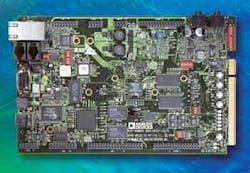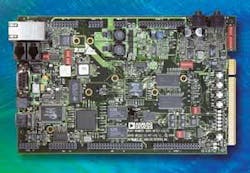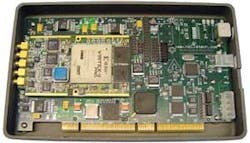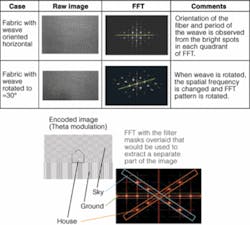Vision shines at NIWeek
Analog and digital I/O boards, embedded DSPs, and machine-vision applications were the highlights of this year’s NIWeek.
By Andrew Wilson, Editor
Says Doug Wilson, president of PVI Systems, a machine-vision-system integrator, “Everyone who leaves the National Instruments NIWeek conference and trade show feels good about technology and the applications for which it can be used.” Indeed, the event, held Aug. 16-18 in Austin, TX, was more than worthwhile on a number of levels. Of course, NI used the event to showcase a number of new products (see box on p. 53). More importantly, however, the event gave attendees the opportunity to discover new technologies and how to apply them in future machine-vision and image-processing applications.
To kick off the event, NI staged a demonstration of how its products are being used in applications that involve protecting operators of table saws and how machine vision and industrial controls can be used to sort ball bearings (see “Vision system sorts ball bearings,” p. 25).
EMBEDDED SYSTEMS
At the conference, the move toward embedded high-bandwidth products continued unabated as the PXI Systems Alliance launched its PXI Express Specification, which integrates PCI Express and CompactPCI technology into the PXI standard. With PXI Express, bandwidths of up to 6 Gbytes/s per system will be achievable, a rate 45 times faster than traditional PXI systems. While no products based on the standard were announced, it is expected that manufacturers of some of the 1150 existing PXI products will endorse the standard. According to the PXI Systems Alliance, PXI Express is also compatible with modules conforming to the new CompactPCI Express (EXP.0) Specification from the PCI Industrial Computer Manufacturers Group that defines both module and slot types.
For the embedded-system designer, however, the most important announcement of the show was NI’s endorsement of the Blackfin digital-signal processor (DSP) from Analog Devices Inc. (ADI). The public beta version of the NI LabVIEW Embedded Module for ADI Blackfin processors provides design engineers with a means to program the processor using LabVIEW. The beta version includes Blackfin-specific, hand-optimized analysis and signal-processing functions; integrated I/O such as audio and video DACs, ADCs, and CODECs; and on-chip debugging capability. Engineers can design their applications using LabVIEW and integrate legacy C code within their LabVIEW diagrams.
While the idea behind this concept is excellent, a demonstration on the show floor illustrated the work that still needs to be done to seamlessly integrate a high-level language with a DSP. At its booth, ADI showed a prototype development kit, called EZ-Kit Lite, interfaced to a parallel port that included a CMOS imager from Omnivision (see Fig. 1). In the demonstration, digitized video from the camera was processed by the ADSPBF561 Blackfin processor and displayed through the JTAG digital output of the development kit through an USB JTAG in-circuit emulator (ICE) from Hewlett-Packard.
Using LabVIEW embedded for Blackfin, Glen Anderson, IDDE manager with ADI, showed how it was possible to generate C code, feed this directly to ADI’s compiler, and run the code directly on the Blackfin processor. While the demonstration was impressive, further analysis of the LabVIEW code revealed that, at present, the algorithms called from LabVIEW and tailored to run specifically on the Blackfin were biased more toward one-dimensional signal processing than machine vision and image processing.
Rather than set its sights on DSP-based systems, start-up Samplify Systems chose NIWeek to demonstrate how an analog signal sampled at up to 100 MSamples/s could be compressed using a Xilinx Xtreme DSP development board built by Nallatech (see Fig. 2). “We chose this board,” says Bryan Hoyer, business-development manager, “because the Xilinx FPGA is already wired to high-speed A/D and D/A converters, so we could compress any analog signal.” The Samplify demonstration allowed show visitors to explore the effects of the company’s SignalZIP lossless and Samplify lossy compression in real time and to see what happens to the time-domain and frequency-domain waveforms. A software-evaluation program called Samplify for Windows, with bit-for-bit identical compression results to the FPGA version, is available for download from the company’s Web site. A demonstration of this algorithm is available on the company’s Web site. According to Hoyer, Samplify is currently evaluating the algorithm for image-compression applications.
STANDARDIZED ALGORITHMS
As NI pushes its products further into the embedded signal- and image-processing markets, it is also working to develop standards for algorithm development. To do this, the company is encouraging third-party vendors to join with independent standards organizations.
“Our industry has been lacking a unified and standardized mathematical foundation for a long time,” says Ali Maleki, brake and chassis electronics program manager at Arvin Meritor, a supplier of integrated systems, modules, and components to the motor-vehicle industry. “Today, each tool offers its own specific set of functions, often with steep learning curves that require us to develop algorithms and skills that are not easily portable across the industry. These algorithms must be rewritten with new projects and new technologies, which ultimately drive costs higher. A standard set of mathematical functions based on industry-accepted semantics would go a long way in creating portable skills and off-the-shelf libraries and tools that would be plug-and-play in various environments and help our bottom line,” he says.
To do this, the newly established Numerical Mathematics Consortium announced that The French National Institute For Research in Computer Science and Control, Maplesoft, Mathsoft, and NI would work together to define a consistent foundation for numerical programming. The consortium will establish an open mathematical semantics standard for numerical-algorithm development to enable portability and reuse among tools, platforms, and disciplines. The organization’s objective is to create a specification that defines core mathematical functions that can be implemented in industrial control, embedded design, and scientific research.
“With the industry-standard specification developed by the Numerical Mathematics Consortium, students can create algorithms compatible with common functionality in traditional tools and feel confident that their designs will work properly in other mathematics-based environments,” says Robert H. Bishop, professor and chairman of the University of Texas aerospace engineering and engineering mechanics department. “With an established mathematics standard, I can ensure that students are learning with the same tools and approaches they will encounter in industry.”
SOFTWARE AT WORK
In addition to encouraging third-party suppliers to develop standards-based systems, NI used its conference to educate its customers about the benefits of its LabVIEW-based software. In numerous papers, engineers from around the world showed how the software could be used in applications such as validating the quality of displays used in cellular telephones (see “Vision system tests cell-phone displays,” p. 55). Vendors provided information about machine-vision lighting, systems design, and software.
One paper by Sam Hammond, chief engineer of Innoventor, highlighted the benefits of performing image-processing and machine-vision functions using the Fast Fourier transform (FFT). Hammond described how the transform can be used in composite fabric inspection. “When an image of a fabric weaved horizontally is imaged and the FFT applied,” says Hammond, “the orientation of the fiber and period of the weave can be observed from the bright spots in each quadrant of the FFT. When the weave is rotated, the spatial frequency is changed and the FFT pattern is rotated.” Imaging the weave and performing the FFT on the image provides an effective way to determine the weave orientation (see Fig. 3).
“In a similar manner,” says Hammond, “detecting whether specific objects exist in a given image can be accomplished using the FFT.” Hammond showed an image consisting of a house, ground, and sky. “When the FFT of such an image is performed, the different frequency components of the objects used can be seen. By filtering the image using a simple mask of the FFT and performing the inverse FFT, these image components can be located,” he says.
For those building industrial-automation equipment, NIWeek provided an invaluable look into future technologies, products, and applications. While new products were announced, the heart of the conference remains technology and applications.
New products target data acquisition and signal processing
FireWire frame grabber with onboard digital I/O
The NI PCI-8254R board, which features NI reconfigurable I/O technology, combines an IEEE 1394 host adaptor with the digital I/O required for industrial control and communication. With the board, engineers building machine-vision systems now can trigger and synchronize multiple IEEE 1394 (FireWire) cameras without requiring additional digital I/O or custom circuitry.
ExpressCard MXI and PCMCIA CardBus interfaces
Using the PCI Express interface, ExpressCard MXI allows control of PXI/CompactPCI systems from laptop computers with an ExpressCard slot. The ExpressCard standard works with both USB 2.0 and PCI Express, and host slots accept modules that use either interface.
LabVIEW embedded module for ADI Blackfin processors
With this new intuitive software, more engineers can take advantage of embedded technology to increase productivity and reduce time to application. The beta version builds on LabVIEW Embedded technology and includes Blackfin-specific functions; such as integrated I/O such as audio and video DACs, ADCs, and CODECs and on-chip debugging.
MXI-Express kits for PCI Express control of PXI and CompactPCI systems
Based on PCI Express, MXI-Express delivers 110-Mbytes/s bandwidth to PXI systems, a more than 40% increase compared to PCI remote control of PXI with MXI-4. The NI PXI-PCIe8361 kit includes a X1 PCI Express board with one X1 cabled PCI Express link, PXI system controller module, and cable. The NI PXI-PCIe8362 kit provides two X1 PCI Express links, each of which can cable to individual PXI chassis. This gives engineers control of two PXI systems from a single PCI Express slot in the PC.
PC-based multifunction data-acquisition (DAQ) devices for PCI Express
The NI PCIe-6251 and NI PCIe-6259 DAQ devices combine the PCI Express bus with the company’s M Series DAQ to offer analog and digital I/O with the per-slot bandwidth of PCI Express. The devices feature up to 32 analog channels with 16-bit, 1.25-MS/s sampling speed and 10-MHz digital I/O on up to 32 lines.
Eight USB 2.0 high-speed DAQ devices
With sampling rates up to 800 kS/s, the new USB 2.0 DAQ devices include the USB-9211A, a four-channel, 24-bit thermocouple input module; USB-9215A, a four-channel, 16-bit simultaneous-sampling analog input at 100 kS/s per channel; USB-9201, an eight-channel, 12-bit analog voltage input at 500 kS/s; USB-9221, an eight-channel, 12-bit high-voltage analog input at 800 kS/s; USB-9233, a four-channel, 24-bit IEPE analog input module; USB-9421, an eight-channel, 24-V digital input module; USB-9472, an eight-channel, 24-V digital output module; and USB-9481, a four-channel, high-voltage relay module.
Company Info
Analog Devices
Norwood, MA, USA
www.analog.com
Arvin Meritor
Detroit, MI, USA
www.arvinmeritor.com
French National Institute For Research in Computer Science and Control
Rocquencourt, France
www.inria.fr
Hewlett-Packard
Palo Alto, CA, USA
www.hp.com
Innoventor
Maryland Heights, MO, USA
www.innoventor.net
Maplesoft
Waterloo, ON, Canada
www.maplesoft.com
Mathsoft
Cambridge, MA, USA
www.mathsoft.com
Nallatech
Glasgow, UK
www.nallatech.com
National Instruments
Austin, TX, USA
www.ni.com
Numerical Mathematics Consortium
Austin, TX, USA
www.nmconsortium.org
Omnivision
Sunnyvale, CA, USA
www.ovt.com
PCI Industrial Computer Manufacturers Group
www.picmg.org
PVI Systems
Niantic, CT, USA
www.pvisys.com
PXI Systems Alliance
www.pxisa.org
Samplify Systems
Portola Valley, CA, USA
www.samplify.com
University of Texas Aerospace Engineering and Engineering Mechanics Department
Austin, TX, USA
www.ae.utexas.edu



